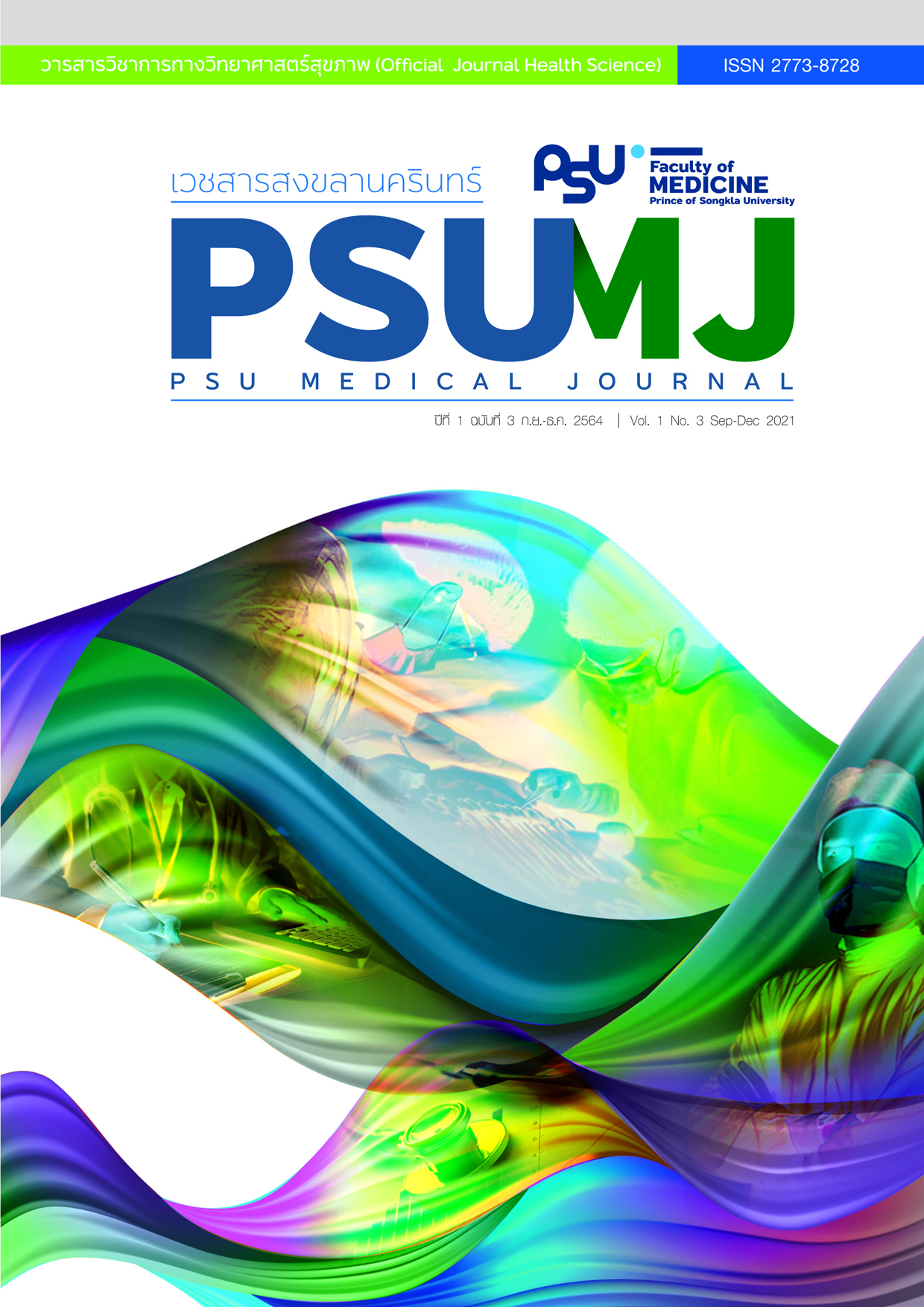Efficacy of Intravenous Glucose for Preventing Postoperative Nausea and Vomiting after Abdominal Hysterectomy under General Anesthesia
Intravenous Glucose in Prevention of Post-operative Nausea and Vomiting
DOI:
https://doi.org/10.31584/psumj.2022249355Keywords:
Intravenous glucose, Postoperative nausea and vomiting, Total abdominal hysterctomyAbstract
Objective: This study aimed to evaluate the ability of intravenous glucose administration during the maintenance of anesthesia as an alternative method for diminishing the incidence of postoperative nausea and vomiting (PONV) in patients undergoing total abdominal hysterectomy (TAH).
Material and Methods: This was a prospective, double-blind randomized placebo-controlled trial. One hundred and ten patients who were 18 - 65 years old, American Society of Anesthesiology (ASA) 1 or 2 and required general anesthesia for TAH, were divided randomly to receive 5% DNSS (Group D) or normal saline (Group N) as a maintenance fluid at a rate of 2 mL/kg/hr. The primary outcome was the incidence of PONV at the arrival time in post-anesthetic care unit (PACU). The secondary outcomes were severity of PONV, time to first dose of an antiemetic drug, amount of antiemetic dose, and length of stay in the hospital.
Results: The incidence of PONV in group N was 5.5% and in group D was 10.4% (p-value = 0.360). There were no statistically significant differences regarding the VRS scores, time to the first dose of antiemetic drug, the amount of antiemetic drug, and length of hospital stay between the 2 groups.
Conclusions: There was no significant difference in efficacy between intravenous glucose administration and placebo in the prevention of PONV in patients undergoing abdominal hysterectomy under general anesthesia.
References
Chandrakantan A, Glass PS. Multimodal therapies for postoperative nausea and vomiting, and pain. Br J Anaesth 2011; 107(Suppl 1):i27-40.
Mishra A, Pandey RK. Is perioperative administration of 5% dextrose effective in reducing the incidence of PONV in laparoscopic cholecystectomy?: A randomized control trial. J Clin Anesth 2017;40:7-10.
Dabu-Bondoc S, Vadivelu N, Shimono C. Intravenous dextrose administration reduces postoperative antiemetic rescue treatment requirements and postanesthesia care unit length of stay. Anesth Analg 2013;117:591-6.
Choi SU. Is postoperative nausea and vomiting still the big “little” problem? Korean J Anesthesiol 2016;69:1-2.
Pakpirom J, Asampinwat T, Nuanjun K, Watanayomnaporn E. A randomized control trial of a multimodal antiemetic management for the prevention of postoperative nausea and vomiting in patients undergoing ambulatory gynecologic endoscopic surgery. J Med Assoc Thai 2017;100:549-57.
Frey UH, Funk M, Lohlein C, Peters J. Effect of P6 acustimulation on post-operative nausea and vomiting in patients undergoing a laparoscopic cholecystectomy. Acta Anaesthesiol Scand 2009;53:1341-7.
Charbit B, Albaladejo P, Funck-Brentano C, Legrand M, Samain E, Marty J. Prolongation of QTc interval after postoperative nausea and vomiting treatment by droperidol or ondansetron. Anesthesiology. 2005;102:1094-100.
Yilmaz N, Cekmen N, Bilgin F, Erten E, Ozhan MO, Cosar A. Preoperative carbohydrate nutrition reduces postoperative nausea and vomiting compared to preoperative fasting. J Res Med Sci 2013;18:827-32.
Hausel J, Nygren J, Thorell A, Lagerkranser M, Ljungqvist O. Randomized clinical trial of the effects of oral preoperative carbohydrates on postoperative nausea and vomiting after laparoscopic cholecystectomy. Br J Surg 2005;92:415-21.
De Oliveira GS, Jr., Castro-Alves LJ, Ahmad S, Kendall MC, McCarthy RJ. Dexamethasone to prevent postoperative nausea and vomiting: An updated meta-analysis of randomized controlled trials. Anesth Analg 2013;116(1):58-74.
Gan TJ, Diemunsch P, Habib AS, Kovac A, Kranke P, Meyer TA, et al. Consensus guidelines for the management of postoperative nausea and vomiting. Anesth Analg 2014;118:85-113.
Apfel CC, Kranke P, Eberhart LH, Roos A, Roewer N. Comparison of predictive models for postoperative nausea and vomiting. Br J Anaesth 2002;88:234-40.
Patel P, Meineke MN, Rasmussen T, Anderson DL, Brown J, Siddighi S, et al. The relationship of intravenous dextrose administration during emergence from anesthesia to postoperative nausea and vomiting: a randomized controlled trial. Anesth Analg 2013;117:34-42.
McCaul C, Moran C, O’Cronin D, Naughton F, Geary M, Carton E, et al. Intravenous fluid loading with or without supplementary dextrose does not prevent nausea, vomiting and pain after laparoscopy. Can J Anesth 2003;50:440-4.
Pin-on P, Boonsri S, Klanarong S. Intraoperative intravenous dextrose administration and the incidence of nausea and vomiting after gynecologic laparoscopic surgery: a randomized double-blind controlled study. Chiang Mai Med J 2018;57:61-9.
Hebbard GS, Samsom M, Sun WM, Dent J, Horowitz M. Hyperglycemia affects proximal gastric motor and sensory function during small intestinal triglyceride infusion. Am J Physiol 1996;271(5Pt1):G814-9.
Griffenhagen GB, Hawkins LL. Facts and comparisons: Handbook of nonprescription drugs. 6th ed. Washington DC: American Pharmacists Association; 1989;p.107.
Mythen MG, Webb AR. Perioperative plasma volume expansion reduces the incidence of gut mucosal hypoperfusion during cardiac surgery. Arch Surg 1995;130:423-9.
Harris B, Schopflin C, Khaghani C, Edwards M. Perioperative intravenous fluid prescribing: A multi-centre audit. Perioper Med (Lond) 2015;4:15.
Chin KJ, Macachor J, Ong KC, Ong BC. A comparison of 5% dextrose in 0.9% normal saline versus non-dextrosecontaining crystalloids as the initial intravenous replacement fluid in elective surgery. Anaesth Intensive Care 2006;34:613-7.
Burton D, Nicholson G, Hall G. Endocrine and metabolic response to surgery. Contin Educ Anaesth Crit Care Pain 2004;4:144–147. doi: 10.1093/bjaceaccp/mkh040.
Pierre S, Whelan R. Nausea and vomiting after surgery. Contin Educ Anaesth Crit Care Pain 2013;13:28–32.
Downloads
Published
How to Cite
Issue
Section
License
Copyright (c) 2021 Author and Journal

This work is licensed under a Creative Commons Attribution-NonCommercial-NoDerivatives 4.0 International License.








